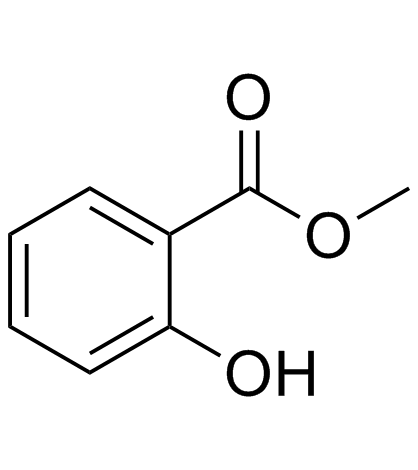Methyl salicylate

Methyl salicylate structure
|
Common Name | Methyl salicylate | ||
|---|---|---|---|---|
| CAS Number | 119-36-8 | Molecular Weight | 152.147 | |
| Density | 1.2±0.1 g/cm3 | Boiling Point | 222.0±0.0 °C at 760 mmHg | |
| Molecular Formula | C8H8O3 | Melting Point | -8 °C | |
| MSDS | Chinese USA | Flash Point | 86.8±12.6 °C | |
| Symbol |

GHS07 |
Signal Word | Warning | |
|
Vestibular dysfunction, altered macular structure and trait localization in A/J inbred mice.
Mamm. Genome 26(3-4) , 154-72, (2015) A/J mice develop progressive hearing loss that begins before 1 month of age and is attributed to cochlear hair cell degeneration. Screening tests indicated that this strain also develops early onset vestibular dysfunction and has otoconial deficits. The purpo... |
|
|
A role for site-specific phosphorylation of mouse progesterone receptor at serine 191 in vivo.
Mol. Endocrinol. 28(12) , 2025-37, (2014) Progesterone receptors (PRs) are phosphorylated on multiple sites, and a variety of roles for phosphorylation have been suggested by cell-based studies. Previous studies using PR-null mice have shown that PR plays an important role in female fertility, regula... |
|
|
The floral transcriptome of Eucalyptus grandis.
New Phytol. 206 , 1406-22, (2015) As a step toward functional annotation of genes required for floral initiation and development within the Eucalyptus genome, we used short read sequencing to analyze transcriptomes of floral buds from early and late developmental stages, and compared these wi... |
|
|
Cheminformatics analysis of assertions mined from literature that describe drug-induced liver injury in different species.
Chem. Res. Toxicol. 23 , 171-83, (2010) Drug-induced liver injury is one of the main causes of drug attrition. The ability to predict the liver effects of drug candidates from their chemical structures is critical to help guide experimental drug discovery projects toward safer medicines. In this st... |
|
|
Evaluation of injection methods for fast, high peak capacity separations with low thermal mass gas chromatography.
J. Chromatogr. A. 1392 , 82-90, (2015) Low thermal mass gas chromatography (LTM-GC) was evaluated for rapid, high peak capacity separations with three injection methods: liquid, headspace solid phase micro-extraction (HS-SPME), and direct vapor. An Agilent LTM equipped with a short microbore capil... |
|
|
Mosquito odorant receptor for DEET and methyl jasmonate.
Proc. Natl. Acad. Sci. U. S. A. 111(46) , 16592-7, (2014) Insect repellents are important prophylactic tools for travelers and populations living in endemic areas of malaria, dengue, encephalitis, and other vector-borne diseases. DEET (N,N-diethyl-3-methylbenzamide) is a 6-decade-old synthetic repellent, which is st... |
|
|
Comparison of Aroma-Active Volatiles in Oolong Tea Infusions Using GC-Olfactometry, GC-FPD, and GC-MS.
J. Agric. Food Chem. 63 , 7499-510, (2015) The aroma profile of oolong tea infusions (Dongdingwulong, DDWL; Tieguanyin, TGY; Dahongpao, DHP) were investigated in this study. Gas chromatography-olfactometry (GC-O) with the method of aroma intensity (AI) was employed to investigate the aroma-active comp... |
|
|
Volatile compounds of Viola odorata absolutes: identification of odorant active markers to distinguish plants originating from France and Egypt.
Chem. Biodivers. 11(6) , 843-60, (2014) Absolutes isolated from Viola odorata leaves, valuable materials for the flavor and fragrance industry, were studied. Violets are mainly cultivated in France and Egypt and extracted locally. The absolutes of the two origins showed different olfactory profiles... |
|
|
Quantitative structure-activity relationship and complex network approach to monoamine oxidase A and B inhibitors.
J. Med. Chem. 51 , 6740-51, (2008) The work provides a new model for the prediction of the MAO-A and -B inhibitor activity by the use of combined complex networks and QSAR methodologies. On the basis of the obtained model, we prepared and assayed 33 coumarin derivatives, and the theoretical pr... |
|
|
Differential combinatorial coding of pheromones in two olfactory subsystems of the honey bee brain.
J. Neurosci. 35(10) , 4157-67, (2015) Neural coding of pheromones has been intensively studied in insects with a particular focus on sex pheromones. These studies favored the view that pheromone compounds are processed within specific antennal lobe glomeruli following a specialized labeled-line s... |